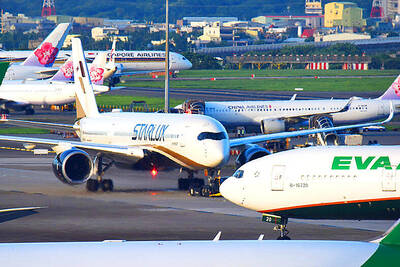The country's private and public power companies yesterday vowed to become more environmentally friendly while taking part in a ceremony to highlight the achievements of the energy industry in greenhouse gas management.
At the ceremony, Minister of Economic Affairs Steve Chen (
"The reduction in greenhouse gases would be equivalent to what 12,860 Da-an Forest Parks could absorb," he said.
"Though Taiwan isn't in the UN, we are part of the global village," Bureau of Air Quality Protection and Noise Control Director-General Hsiao Hui-chuan (蕭慧娟) said. "I am most happy to see the business sector being proactive in climate change prevention, since it affects all mankind."
Though the administration's greenhouse gas reduction law did not pass before the legislative session closed, the Environmental Protection Administration (EPA) is working rigorously to fight global warming, she said.
The current priority for the EPA and Bureau of Energy (BOE) is to quantify and register carbon emission amounts for all businesses, she said.
Last year the bureau launched an anti-global warming effort called the "energy industry voluntary greenhouse gas reduction plan," BOE Director-General Yeh Huey-ching (葉惠青) said at the ceremony.
Since then, four power plants have quantified their carbon emissions and completed a reduction plan that complies with stringent International Organization for Standardization (ISO) and Clean Development Mechanism (CDM) guidelines, and obtained ISO 14064-2 certification, he said.
ISO 14064-2 certification is an international standard for reporting emissions at the project level.
CDM is an arrangement under the Kyoto Protocol for developed countries to invest in carbon reduction projects in developing countries instead of in their home countries [to produce the same reduction effect while saving on cost], he said.
Taiwan Power Co's (台電) Tai-chung plant, CPC's (台灣中油) Tao-yuan refinery, Taipower's Tunghsiao plant (通霄) and Taipower's Hsin-ta plant (興達) were all lauded yesterday for their achievements.
Those with the certification can then log their emission amounts for future trading purposes, Yeh said.
Yeh said that the BOE had had a fruitful two years since the launch of the voluntary reduction plan because most power companies are now under carbon emission monitoring.
"Currently 83 percent of all power companies in Taiwan have completed their carbon emission quantification and registrations," Yeh said.
Fifteen power plants have obtained ISO 14064-1 certification, an international standard for reporting emissions at the organizational level, he said.
Ten of the plants obtained certification this year and received award certificates from Yeh at the ceremony.
"Though it is not yet a law in Taiwan, carbon reduction is a global trend; I urge all businesses to follow suit and register their emissions as soon as possible," Yeh said.

The disruption of 941 flights in and out of Taiwan due to China’s large-scale military exercises was no accident, but rather the result of a “quasi-blockade” used to simulate creating the air and sea routes needed for an amphibious landing, a military expert said. The disruptions occurred on Tuesday and lasted about 10 hours as China conducted live-fire drills in the Taiwan Strait. The Civil Aviation Administration (CAA) said the exercises affected 857 international flights and 84 domestic flights, affecting more than 100,000 travelers. Su Tzu-yun (蘇紫雲), a research fellow at the government-sponsored Institute for National Defense and Security Research, said the air

Taiwan is to commence mass production of the Tien Kung (天弓, “Sky Bow”) III, IV and V missiles by the second quarter of this year if the legislature approves the government’s NT$1.25 trillion (US$39.78 billion) special defense budget, an official said yesterday. Commenting on condition of anonymity, a defense official with knowledge of the matter said that the advanced systems are expected to provide crucial capabilities against ballistic and cruise missiles for the proposed “T-Dome,” an advanced, multi-layered air defense network. The Tien Kung III is an air defense missile with a maximum interception altitude of 35km. The Tien Kung IV and V

Trips for more than 100,000 international and domestic air travelers could be disrupted as China launches a military exercise around Taiwan today, Taiwan’s Civil Aviation Administration (CAA) said yesterday. The exercise could affect nearly 900 flights scheduled to enter the Taipei Flight Information Region (FIR) during the exercise window, it added. A notice issued by the Chinese Civil Aviation Administration showed there would be seven temporary zones around the Taiwan Strait which would be used for live-fire exercises, lasting from 8am to 6pm today. All aircraft are prohibited from entering during exercise, it says. Taipei FIR has 14 international air routes and

Taiwan lacks effective and cost-efficient armaments to intercept rockets, making the planned “T-Dome” interception system necessary, two experts said on Tuesday. The concerns were raised after China’s military fired two waves of rockets during live-fire drills around Taiwan on Tuesday, part of two-day exercises code-named “Justice Mission 2025.” The first wave involved 17 rockets launched at 9am from Pingtan in China’s Fujian Province, according to Lieutenant General Hsieh Jih-sheng (謝日升) of the Office of the Deputy Chief of the General Staff for Intelligence at the Ministry of National Defense. Those rockets landed 70 nautical miles (129.6km) northeast of Keelung without flying over Taiwan,